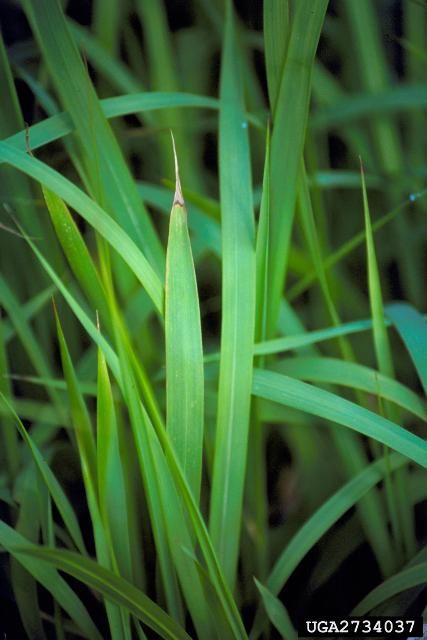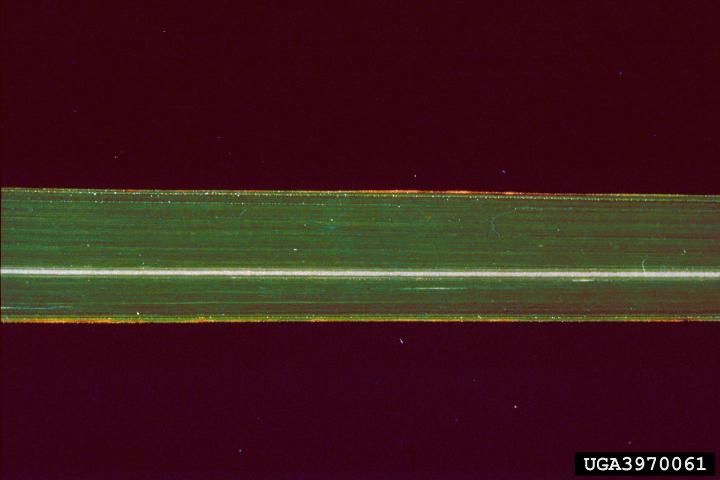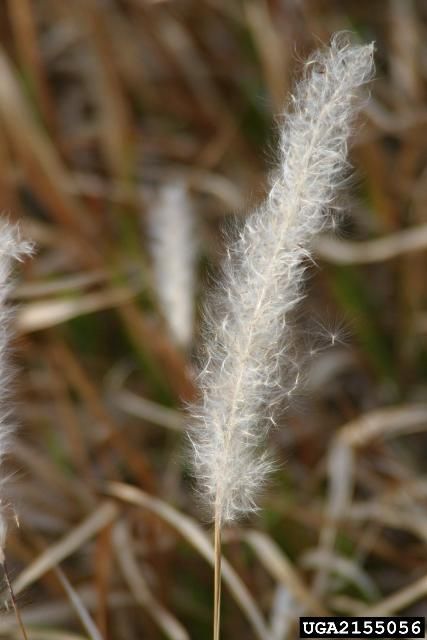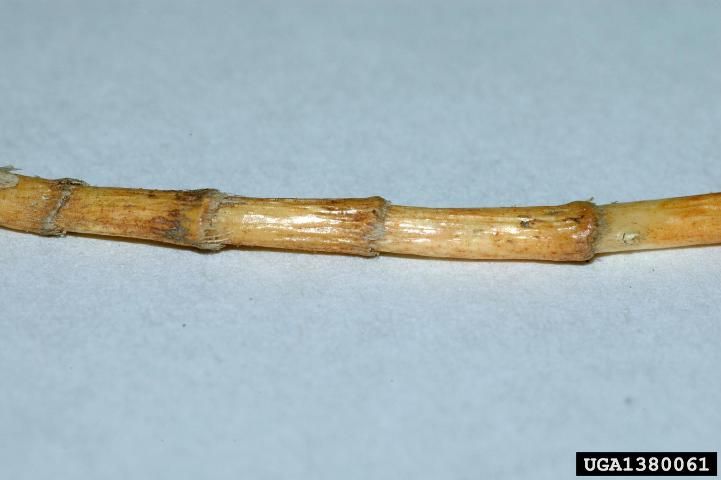Cogongrass is found on every continent and is considered a weedy pest in 73 countries. In the United States, cogongrass is found primarily in the Southeast. It was accidentally introduced into Alabama in the early 1900s, and purposely introduced as a potential forage and soil stabilizer in Florida (and other states) in the 1930s and early 1940s. However, soon after investigations began it was realized that cogongrass could be a weedy pest. Since its introduction, cogongrass has spread to nearly every county in Florida. In some cases, it has completely taken over pastures so that it is the only species present. This is a common thread where cogongrass invades; it quickly displaces desirable species and requires intensive management.
There are many reasons why cogongrass is such a prolific invader. It is a warm-season, perennial grass species with an extensive rhizome root system. In fact, at least 60% of the total plant biomass is often found below the soil surface. In addition to the rhizome root system, cogongrass adapts to poor soil conditions, and its fires burn so hot that they eliminate nearly all native species. Cogongrass is drought tolerant and has prolific wind-dispersed seed production. Additionally, it can grow in both full sunlight and highly shaded areas, although it is less tolerant to shade.
Cogongrass spreads through its creeping rhizome system and seed production. The rhizomes can penetrate to a depth of 4 feet, but most of the root system is within the top 6 inches of the soil surface. The rhizomes are responsible for long-term survival and short-distance spread of cogongrass. Long-distance spread is accomplished through seed production. Seeds can travel by wind, animals, and equipment. Seed viability is significant in north Florida and other states of the Southeast; however, there are no confirmed cases of viable seed production in central and south Florida.
An established cogongrass stand invests heavily in its perennial root system. These infestations are capable of producing over 3 tons of root biomass per acre. This extensive network of rhizomes is capable of conserving water while the top growth dies back during prolonged drought. This is essentially a survival mechanism to keep the rhizome system alive. Another key to cogongrass invasion is that the root system may produce allelopathic chemicals that reduce the competitive ability of neighboring plants.
Identification
Several distinctive features aid in the identification of cogongrass. First, cogongrass infestations usually occur in circular patches. The grass blades tend to be yellow to green in color (Figure 1). Individual leaf blades are flat and serrated, with an off-center prominent white midrib (Figure 2). The leaves reach 2–6 feet in height. The seed head (Figure 3) is fluffy, white, and plume-like. Flowering typically occurs in spring or after disturbance of the sward (mowing, etc.). Seed heads range from 2 to 8 inches in length and can contain up to 3,000 seeds. Each seed contains silky-white hairs that aid in wind dispersal. When dug, the rhizomes (Figure 4) are white, segmented (have nodes), and are highly branched. The ends of the rhizome are sharp pointed and can pierce the roots of other plants.

Credit: G. Keith Douce, University of Georgia, www.forestryimages.org.

Credit: L. M. Marsh, Florida Department of Agriculture and Consumer Services, www.forestryimages.org.

Credit: John D. Byrd, Mississippi State University, www.forestryimages.org.

Credit: Chris Evans, River to River CWMA, www.forestryimages.org.
Forage Value
Cogongrass has been used in Southeast Asia as forage because it is the dominant vegetation on over 300 million acres. In these areas it was found that only very young shoots should be grazed or cut for hay. At this stage, the leaves lack sharp points and razor-like leaf margins. For about four weeks following a prescribed burn, crude protein of regrowth is comparable to bahiagrass. Crude protein of mature stands rarely attains the minimal 7% level needed to sustain cattle, making supplementation essential for livestock production. Cogongrass yields are relatively low, even under heavy fertilization, and usually do not exceed 5 tons per acre.
Management
For many years researchers all over the world have studied cogongrass control. During this time nearly all available herbicides have been tested, but few effective products have been found. For example, all of the commonly used pasture herbicides such as metsulfuron, 2,4-D, triclopyr, Velpar, and other combinations have little to no activity on cogongrass. Only glyphosate (Roundup, etc.) and imazapyr (Arsenal, Stalker, etc.) herbicides have been found to be effective, but long-term control is rarely achieved.
Imazapyr is an extremely effective herbicide that controls a variety of weeds, from herbaceous to woody species. One or two applications of imazapyr (0.75 lb/acre) will often effectively control cogongrass for 18–24 months. However, there are several disadvantages to using this herbicide. First, imazapyr will severely injure or kill forage grasses such as bermudagrass and bahiagrass. It also has a long soil half-life and will remain in the soil for several months after application. This often leads to "bare ground" for up to 6 months in the application area because of the non-selective nature of this herbicide. Imazapyr also has the potential to move down slopes during periods of rainfall, killing or injuring other species in the runoff area (oaks and other hardwood trees are especially sensitive). Second, imazapyr can only be used as a "spot-treatment" with no more than 10% of the pasture area treated per year.
Similarly, glyphosate is also a non-selective herbicide that effectively controls a variety of weeds. Unlike imazapyr, glyphosate possesses very little to no soil activity. Non-target effects caused by runoff during high rainfall events are not likely. Since glyphosate has no soil activity, it does not take very long for weeds or desirable grasses to reinfest the treated areas. Cogongrass will likely reinfest the area if only one application of glyphosate is applied during the same year. Research in Alabama has revealed that it takes approximately three years of two applications per year to reduce cogongrass rhizome biomass by 90%.
Small Infestations
Early detection of cogongrass in any setting is extremely important. A young infestation will be much easier to treat and eradicate than established infestations. In this case, we would define a small patch as 20–30 feet or less in diameter. Even for a small patch, monitoring is required after the initial application to ensure that any re-sprouting is quickly treated. See Table 1 for specific timelines and suggested herbicide rates.
Large Infestations
Large infestations are 30 feet or larger in diameter. These types of infestations can be considered as established and likely have a large, intact root system. This will require more herbicide treatments to completely eradicate cogongrass. See Table 2 for specific timelines and suggested herbicide rates.
Integrated Management
Herbicide inputs alone are rarely successful in eradicating perennial species like cogongrass. In these cases, we need to use all of the tools we have to remove an unwanted species to reestablish a desirable species. This type of strategy is best employed in an area where cogongrass has long been established and is the predominant species present. See Table 3 for specific timelines and suggested herbicide rates.
In general, burn the area infested with cogongrass in August to September. One to four months later, treat the burned area with a mixture of imazapyr and/or glyphosate. Take soil samples prior to spring tillage the next growing season to ensure that the soil pH is adequate for your desirable forage species. Till the treated area the following spring to a depth of at least 6 inches and prepare a seedbed.
Consult with your local county Extension agent to consider your options for forage cultivars and fertility recommendations. Getting a good start on the desirable forage will help limit cogongrass reinfestations in your pasture. Continue to monitor this area in six-month intervals until the fourth year. Spot treat with glyphosate when necessary to remove any new cogongrass growth.
Tables
Herbicide suggestions for small infestations of cogongrass in grazing areas. This includes both improved and native rangeland. These concentrations are good for mixing in small (3–30 gallon) sprayers. Please read the entire label of the suggested products prior to treating existing cogongrass stands.
Herbicide suggestions for large cogongrass infestations in grazing areas, including both improved and native rangeland. These suggestions are intended for large (>1000 gallon) sprayers. Please read the entire label of the suggested products prior to treating existing cogongrass.
Control of cogongrass using an integrated approach. Adjust your timelines based on your location in Florida. For example, burning should be performed earlier in north Florida than in south Florida because of the first onset of a potential killing frost. Please read all herbicide labels prior to treating cogongrass for restrictions and mixing instructions.